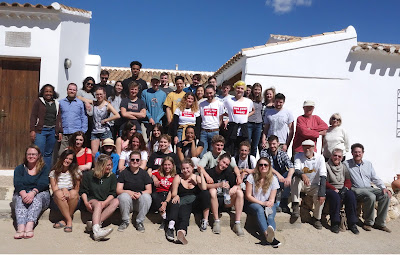I'm just back from a trip to the
Urra Field Centre in Almeria Province, Spain, where I was helping students studying
Ecology & Conservation Biology at Leeds University with some of their field projects.
My specific role (assisting ex-pat ringer and external tutor Richard Banham) was to supply birds to two groups of students, a trio of undergraduates whose field project concerned the relationship between
feather-mite load and the morphology of the uropygial gland, and a pair of masters students investigating the differences in fat and muscle scores in migratory and resident species (not as simple as you might think - how often do we look at the fat on non-migratory birds?).
 |
| Ed - Richard - Kieran - Marnie - Lewis - Roxanne |
Other groups of students were working on flowers, ants, bees, spiders, scorpions, lizards, and so on.
The species providing the bulk of the data were House Sparrows, Sardinian Warblers, Robins and Blackcaps, all of which we were colour ringing as part of other long-term studies...
...but of course there was also a nice supporting cast of other species for me to ring:
 |
| Rock Sparrow |
 |
| Corn Bunting |
 |
| Cirl Bunting |
 |
| Black Redstart (male) |
|
 |
| Black Redstart (female) |
 |
| Bluethroat |
 |
| Blue Rock Thrush |
Also Siskin, Chaffinch, Greenfinch, Spotless Starling, Song Thrush, Chiffchaff, Willow Warbler, Whitethroat, Common Redstart, Great Tit and Thekla Lark.
My bogey-bird was the Great Spotted Cuckoo, of which there were a pair in the area, but once one of them had managed to escape from a net just before I reached it, they weren't going to be caught again. At least I managed a decent picture of one of them.
This is very dry country at the best of times - just down the road from Tabernas desert where there was
once a thriving industry making Western films such as The Good, the Bad, and the Ugly - and not helped by the extraction of groundwater on an industrial scale for vast new plantations of olive trees. This Spring has been particularly dry there, and there was as well a worrying scarcity of the trans-Saharan migrants that should have been arriving by now.
 |
| Four furled nets down there, around some small artificial pools |
 |
| We had six nets across this dry riverbed |
 |
| Paella night |





























